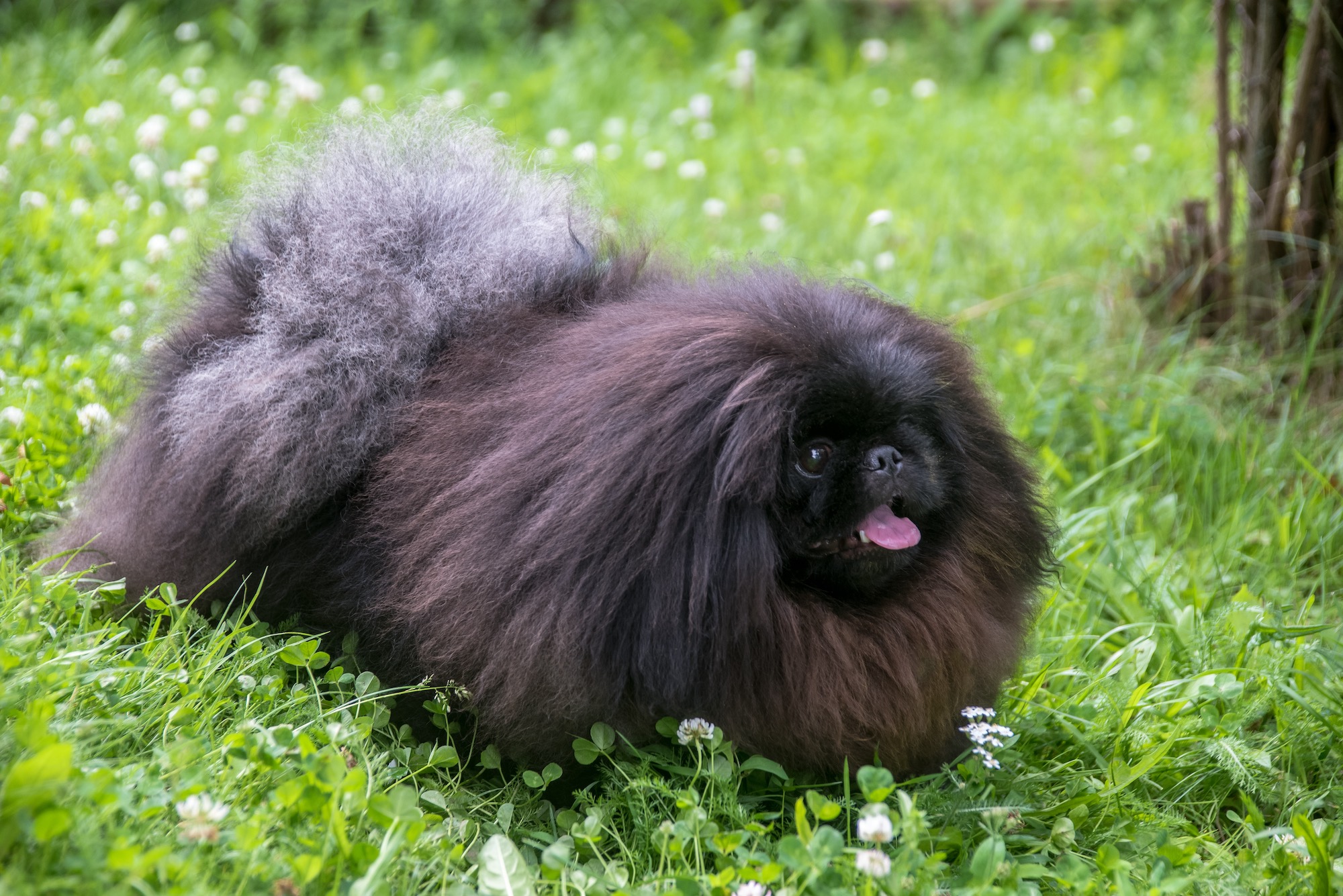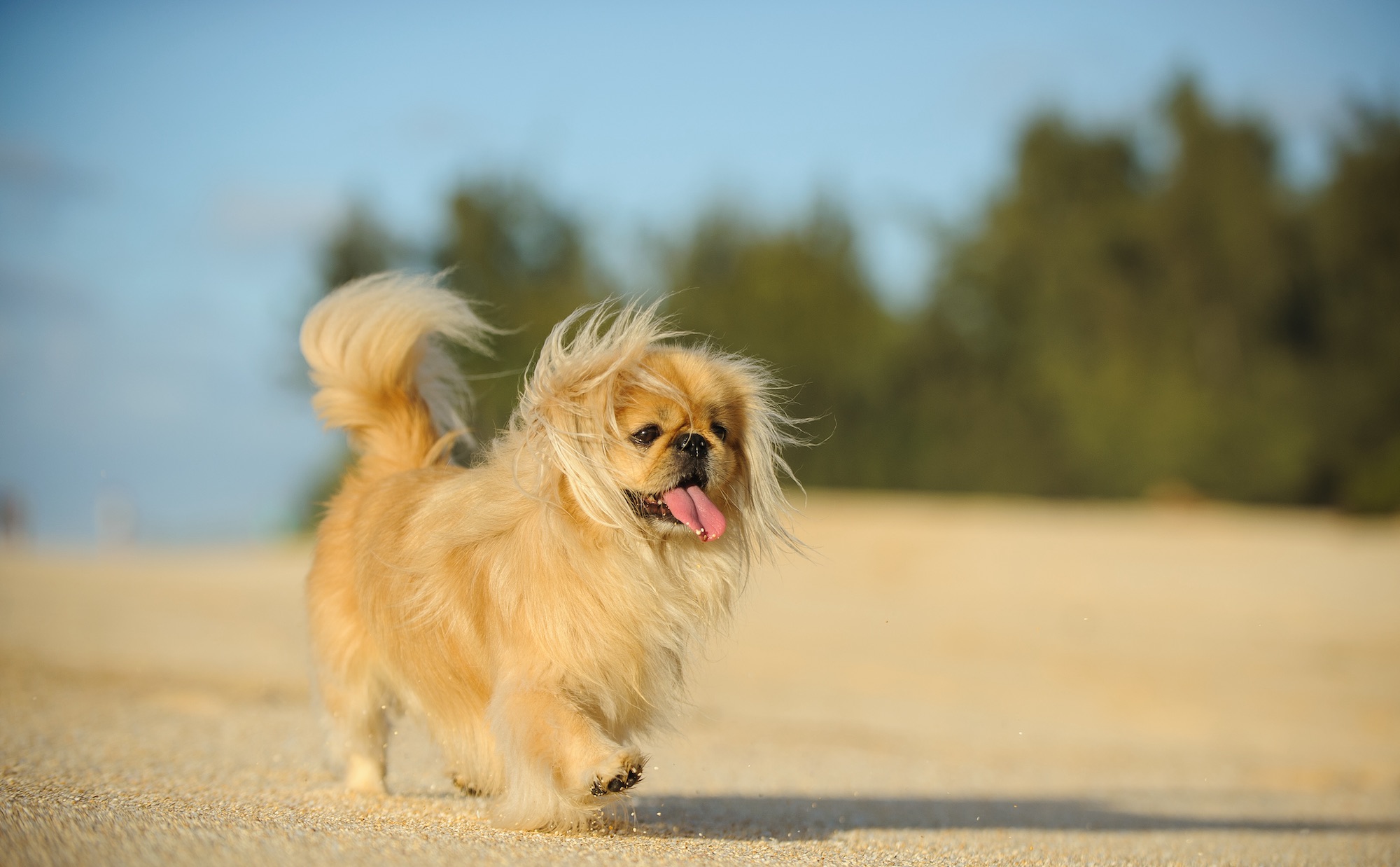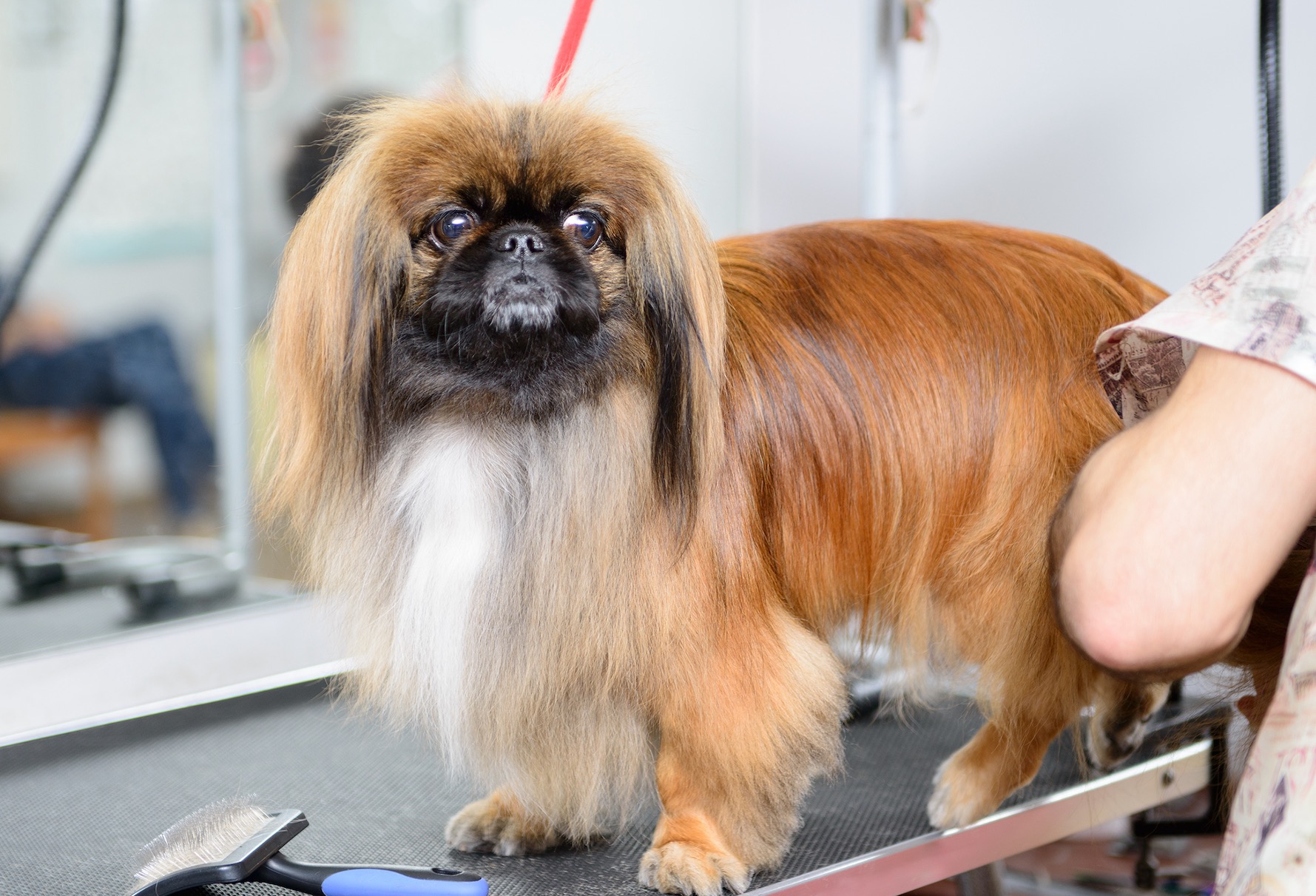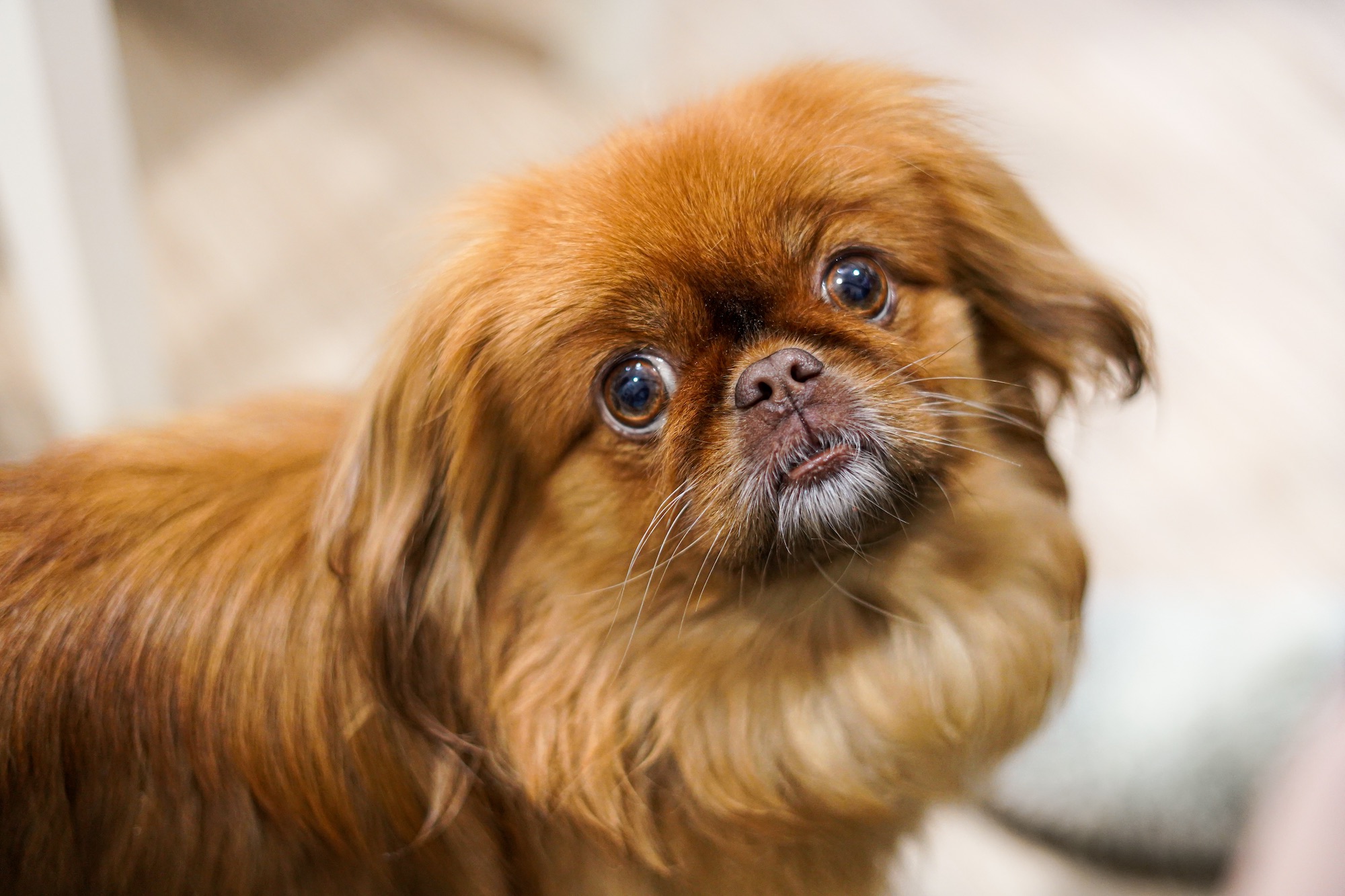With their long fur and lion-like manes, Pekingese have a regal look to match their confident temperament. As you might expect from dogs who started as companions to royalty, they pack a lot of pride and personality into their small bodies.
Whether you’re thinking of getting a Pekingese or want to take better care of the one who already lives with you, here are some of the most important things to know about looking after these charming, affectionate dogs.
Basic Pekingese breed facts
Bred as a companion for Chinese royalty, the Pekingese is a self-possessed—but loving—little companion. Dogs of the breed are known to be somewhat aloof around strangers, but form strong bonds with family and exhibit unwavering loyalty to the ones they love.
The American Kennel Club (AKC) classifies Pekingese in its Toy Group. They average six to nine inches in height, and weigh up to 14 pounds. Though small, Pekingese are stocky and muscular. If in good health, their expected lifespan is 12–14 years.
Perhaps Pekingese’s most distinctive physical quality is their long, flowing double coat. It consists of a long topcoat of straight, coarse fur with a soft undercoat that gives the breed a fluffy appearance.
Pekingese come in a wide range of coat colors, with or without markings. Their fur is thickest around the neck and shoulders, forming a noticeable mane. This appearance, combined with a noble bearing, has earned the breed its “lion dog” nickname. Fans of the breed also often shorten “Pekingese” to “Peke.”
Maintaining the Pekingese’s abundant coat is just one of several duties a responsible owner should be ready to take on. Pekingese are a brachycephalic, or flat-faced, breed. Their shortened snouts contribute to reduced exercise tolerance, and increase their risk for heatstroke. Still, an appropriate amount of daily exercise is essential to their overall health and longevity.
Pekingese breed history
In the early stages of domestication, dogs were kept primarily for utilitarian purposes—hunting, guarding, and herding. Dogs kept only for companionship were largely limited to the aristocracy. Lapdogs, as they came to be called, were fashion accessories and status symbols.
As confirmed by an extensive genetic study, the Pekingese is one of the oldest breeds of lapdog. The Pekingese is believed to have played an important role in the development of modern toy breeds including the shih tzu and pug.
Developed in ancient China, Pekingese were bred small enough to be carried inside the sleeves of a nobles’ robes. While other lapdogs may have existed at the time, the Pekingese was held sacred. The breed was reserved for members of the imperial family and wasn’t introduced to the West until English forces looted the Imperial Palace in 1860.
Only one Pekingese survived the voyage back to England following the destruction of the Old Summer Palace in Beijing. The dog was presented by a British soldier named Captain John Hart Dunne to Queen Victoria, who named the dog “Looty.”
Other notable Pekingese owners have included financier John Pierpont Morgan, entertainer Joan Rivers, and writer and socialite Alice Lee Roosevelt Longworth, daughter of Theodore Roosevelt. Margaret Rummer Godden, an English author, wrote that Pekingese have “such character that they cannot be denied; Pekingese are not dogs but something more.”
Pekingese personality
Though not the most intimidating dogs by size, Pekingese are incredibly observant—and won’t hesitate to announce the arrival of guests. Strangers are likely to be greeted with suspicion, and some Pekingese are very protective of their owners.
Known for their stubborn and dignified personalities, Pekingese aren’t an ideal choice for inexperienced dog owners. “Pekingese are wonderful pets, but need special owners,” says Janice O’Connor, who has 30 years of experience with the breed and runs a Pekingese rescue in Ft. Lauderdale, Florida. “A Peke really owns you and you need to adapt to their needs.”
Pekingese may not be well suited to families with small children, and will not appreciate rough play (in general, you should always supervise children’s interactions with dogs). With early socialization, they should be able to get along with other dogs and people—but watch them closely and make sure they’re enjoying themselves. As with people, if dogs are going to be friends their personalities need to be a good match.
And a reminder: Every dog is different, and Pekingese do not come pre-loaded with a set personality. If your Pekingese behaves differently than you expect, or than other Pekes, that doesn’t mean there’s anything wrong with them; that’s what happens when you take care of an individual dog with their own wants and needs.
Exercise for Pekingese
Pekingese need daily exercise to stay healthy. It is, however, important to avoid overexertion, especially because they are brachycephalic.
Due to the breed’s short snout and narrow airway, Sara Ochoa, DVM says, “Pekingese can struggle with breathing difficulties, exercise intolerance, and heat sensitivity.” She stresses the importance of providing your Pekingese with a cool and well-ventilated environment.
Your Pekingese can benefit from a few gentle 20- to 30-minute walks each day. It’s best to time your walk for the coolest part of the day and bring some water with you. Read up on the signs of heatstroke in dogs so you can monitor your Peke and take early action if the heat becomes too much for them.
Indoor play sessions are good exercise for Pekes as well. Puzzle toys and food-dispensing balls can provide your dog with mental stimulation to help prevent boredom. Supervision is recommended for outdoor play—especially with other dogs. It’s also wise to keep your Pekingese from jumping too much, as they can be prone to back and knee injuries.
Pekingese training
Early socialization and consistent training are essential for this breed—and any dog.
The key to training a Pekingese is to find the right motivation. While some dogs, like many golden retrievers, are eager to please, a Pekingese is more likely to have an independent mindset. You’ll set yourself up for success if you find the right treats, toys, and other rewards that your dog simply can’t resist. Avoid punishment, which will upset your Pekignese and may inadvertently make their behavior problems worse.
Here are some specific considerations for training Pekingese:
Socialization: It’s important to expose your Peke to different sights, sounds, smells, and experiences from a young age. Obedience classes are a great way to set a strong foundation for training and get your Pekingese used to being around other dogs.
Housetraining: In any form of training, consistency is key for Pekingese. Establish the rules from the outset, and stick to them. Give your dog frequent bathroom opportunities, dispense plenty of treats and praise when they do what you like, and never punish them for accidents; doing so can make them try to hide their bathroom activities from you.
Crate training: Pekingnese make faithful companions, but a little strategically planned time alone can help prevent separation anxiety. Getting your dog comfortable in a crate can be good for both of you.
Bark management: The AKC rates Pekingese as being on the quieter side—but they can make excellent watchdogs, because they’re always keeping an eye on their surroundings. Especially if you live in an apartment or have close neighbors, it’s important to start bark management training early. Take care not to inadvertently reinforce demand barking with attention, toys, or treats. Neither should you yell at or punish your dog for barking—it is a natural canine behavior. Instead, patiently reinforce the behavior you want and help your dog get used to the stimuli that trigger their barking.
Grooming your Pekingese
Keeping a Pekingese’s coat clean and healthy is no easy task. If you establish a grooming routine early in your dog’s life, however, it will be much simpler to manage.
As long as you do it regularly to prevent mats and serious tangles, weekly brushing should be sufficient for the most part. Keep in mind that a full brushing session could take up to an hour, so you might prefer to break it up into shorter daily sessions. Some dogs may also require daily combing of the feathered hair on their legs, ears, and tails to prevent mats and tangles.
Here’s how to brush your Pekingese:
- Work on one section of your dog’s body at a time.
- Mist the coat with clean water to help prevent tangles.
- Using a small bristle brush, brush slowly from the root of the fur to the tip.
- Be sure to brush all the way down to your dog’s skin, through the undercoat.
- Work your way around your dog’s body, misting each section with water as you go.
- Use a wide-toothed comb to brush the feathered hair on the legs, ears, and tail.
- Gently clean your dog’s face with a damp cotton pad.
An occasional bath can help keep your Peke’s skin and coat healthy. Avoid bathing them more than once a month, except in heavy shedding seasons (fall and spring) when weekly bathing may help remove dead hair. Check your dog’s ears and nails about once a week, cleaning the ears and trimming the nails as needed.
Daily toothbrushing is recommended for all dogs, but especially for small breeds like the Pekingese. Dr. Ochoa says that Pekingese are prone to dental problems, and “unmanaged dental disease can impact their ability to eat properly.” A dental exam should be included in your Peke’s annual checkup with professional dental cleanings performed as needed.
Common Pekingese health concerns
Healthy Pekingese can live long lives—their life expectancy is typically 12–14 years—but they are predisposed to certain health issues, some of which are related to their brachycephalic anatomy. They’re at particular risk of the following:
Brachycephalic airway obstruction syndrome (BAOS): Many Pekingese exhibit mild to moderate breathing difficulty, often in the form of snuffling, snorting, and snoring. Obesity and exposure to heat can worsen the effects of BAOS. Keeping your dog at a healthy weight; giving them only an appropriate amount and intensity of exercise in an environment with a cool, comfortable temperature; and using a harness rather than a collar can all help alleviate mild cases. Unfortunately, more severe cases require surgery.
Eye problems: Due to their prominent, bulging eyes, Pekingese have an increased risk for eye problems including corneal ulcers and keratoconjunctivitis sicca or dry eye. They are also prone to inherited eye disorders like progressive retinal atrophy (PRA) and entropion. These conditions require attention from a medical professional, so call your vet if you notice any issues with your Pekingese’s eyes.
Luxating patella: Pekingese over-index for patellar luxation, a condition in which the kneecap slips out of its normal position, which can be painful and make moving around difficult for a dog. While mild cases can be managed with medication and exercise restriction, severe cases may require surgical intervention.
Dental disease: Toy breeds like the Pekingese are at an increased risk for dental disease, because their teeth tend to become crowded in their small mouths. Daily toothbrushing is recommended, as are annual dental exams and cleanings. Untreated dental disease can put your Peke at risk for tooth loss, heart disease, and other serious health issues.
Skin problems: Pekingese are prone to skin fold dermatitis and an infection called pyoderma, especially on their faces. This breed is also prone to skin allergies triggered by environmental factors and food ingredients.
Mitral valve disease: A form of heart disease, this condition is most common in older dogs and is characterized by a defect in the mitral valve of the heart. It impairs the flow of blood through the heart, allowing it to back up in the left atrium. More than one-third of dogs over the age of ten suffer from this disease, but Pekingese are genetically predisposed to developing it when they’re younger.
Dr. Ochoa advises owners to remember that not all Pekingese dogs will experience these health conditions. Breeding plays a major role in determining your dog’s risk for certain problems, but “proper care and regular veterinary checkups can go a long way toward preventing and managing these issues.”
Feeding your Pekingese
A complete and balanced diet is key to maintaining your Pekingese’s long-term health. Here are some other important considerations for feeding your little lion:
Watch their weight: Many major Pekingese health concerns can be positively influenced if the dog maintains a healthy weight. Extra weight puts additional stress on the joints, not to mention the heart, lungs, and metabolism, so it’s important to control portions and calorie intake while ensuring proper nutrition. A fresh-food plan makes it easy to feed the right amount of food for their age, size, and activity level.
Allergies and sensitivities: Alleviating or eliminating the triggers to a canine food sensitivity requires identifying the culprits, which can include certain proteins, artificial colors, and other ingredients. Your vet can help with this investigation. Finding a diet that’s compatible with your pet’s allergies might mean trying an elimination diet. But it might also mean avoiding dry, highly processed food. Many commercial dog foods contain a long list of ingredients, and it’s not always clear what all of them are. One study of commercial, over-the-counter processed dog food showed that unlisted ingredients appeared in 13 out of 14 brands tested.
Mind the teeth: Eating for dental health means eating for overall health. A fresh, whole-food diet promotes a healthy immune system, which helps ward off dental maladies.
If a Pekingese sounds like the right dog for you, consider adopting one from a local shelter or rescue. Many Pekingese-focused rescues operate on a foster system, so you may also be able to provide one with a safe place to stay while they await their forever home.













